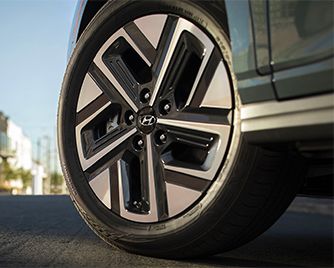Georgetown Hyundai, Your Destination for Your Next Vehicle
Welcome to Georgetown Hyundai, your number one Hyundai dealership in Georgetown, Ontario. We have a full lineup of new Hyundai cars, and we look forward to helping you with our professional team of dedicated sales representatives. They can help you find the perfect new Hyundai starting with our impressive new Hyundai sport utility vehicles.
New Hyundai Sport Utility Vehicles in Georgetown, Ontario
Hyundai offers two small urban sport utility vehicles perfect for life in Georgetown, Ontario. These two SUVs deliver exceptional fuel economy and give you the interior space you’re looking for. Whether you go with the Hyundai Venue or the Hyundai Kona, you will enjoy a spacious and versatile small SUV that delivers everything you want.
If you’re looking for a more spacious option, check out the Hyundai Tucson. The new Hyundai Tucson is one of the most impressive new compact SUVs to arrive on the market this year. The new Tucson features a bold design that has been completely redesigned, as well as more interior space, more efficient engines, and a vastly improved interior. When you buy a Hyundai Tucson, you’re getting a vehicle that has been designed for the needs of families in Georgetown. That said, there are quite a few other sport utility vehicles to consider in the Hyundai lineup. The Hyundai Santa Fe and the spacious 3-row Hyundai Palisade, are two options that give you a lot of space while bringing out the best in what Hyundai does as a brand. The Hyundai Santa Fe, just like the Tucson, is available as a hybrid as well. These vehicles stand out on the road with their stylish designs but they also give their owners the comfort, luxury, features, and driving pleasure that they’re looking for.
New Hyundai Cars at Georgetown Hyundai
Hyundai has a vast sport utility vehicle lineup, but the brand also builds some impressive cars starting with a Hyundai Elantra. The Elantra is not just one of the best-selling cars in North America, it’s also one of the best cars according to multiple outlets. It’s not surprising that the Elantra won North American Car of the Year just a few years ago. This car shines for its value, the quality of its interior and exterior, the design that it offers, and so much more. It’s easy to fall in love with the Elantra. If you want all of the Elantra’s fun factor with more interior space, check out the Hyundai Sonata. Both the Elantra and the Sonata are offered as fuel-efficient hybrid vehicles as well.
We have a range of other models to offer you at Georgetown Hyundai including the Hyundai Veloster, the Hyundai IONIQ electric vehicle, the new Hyundai Santa Cruz, and the Hyundai Kona EV.
The Best Pre-Owned Vehicles in Georgetown
Hyundai gives you a wide range of options when it comes to buying a pre-owned vehicle as well. When you buy a Hyundai used vehicle at Georgetown Hyundai, you’re getting a vehicle that has been inspected and that will never let you down. We take great pride in making sure that the vehicles we offer our clients stand out for quality and dependability. You can buy your next vehicle with complete confidence at Georgetown Hyundai knowing that it’s inspected, it’s protected by a generous extended warranty, and it provides plenty of value.
The Best Service for your Hyundai Vehicle is at Georgetown Hyundai
If you’re looking for quality service and experienced technicians who will never let you down, check out the team at Georgetown Hyundai and our professional service and maintenance experts. We offer our clients a state-of-the-art showroom where everything is put in place to exceed their expectations. We offer a range of services that include maintenance and repairs, genuine Hyundai parts and accessories, and more. Visit us today to learn more.
Learn more





